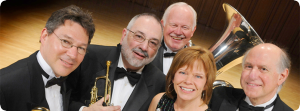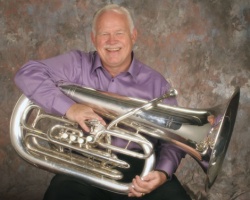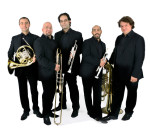 Marty Erickson served as a concerto soloist with the Navy Band, is an accomplished jazz man with three jazz cds to his credit, and presently finds himself utterly devoted to chamber music (with the improvising Millenium Brass)and to his students. A thinking man’s tubist, Erickson draws upon his rich musical life to explore the chamber music ramifications of the euphonium and the tuba, and to contemplate the future young musicians on those instruments might encounter. Though rooted in firm foundations which reach back to Leonard B. Falcone, Erickson has consistently forged beyond convention. Bold, fresh and visionary is Marty Erickson’s design for “The Fourth Valve” tm.
Marty Erickson served as a concerto soloist with the Navy Band, is an accomplished jazz man with three jazz cds to his credit, and presently finds himself utterly devoted to chamber music (with the improvising Millenium Brass)and to his students. A thinking man’s tubist, Erickson draws upon his rich musical life to explore the chamber music ramifications of the euphonium and the tuba, and to contemplate the future young musicians on those instruments might encounter. Though rooted in firm foundations which reach back to Leonard B. Falcone, Erickson has consistently forged beyond convention. Bold, fresh and visionary is Marty Erickson’s design for “The Fourth Valve” tm.
1. Outside the tuba quartet, where do you think that the euphonium player can find meaningful chamber music expression as a student?
The euphonium player needs to think out of the box for extra chamber music experience. The obvious choices are to use the euphonium in brass quintet settings, subbing for the trombone, but with an ear/eye toward appropriate style, etc. However, this should be done in any setting where the euphoniumist can sub for the trombone parts, simply for the benefits of reading everything possible. There are more and more pieces being written for Tuba-Euphonium duet, as witnessed by the wonderful recording and arranging of the the “Symbiosis Duo” with Gail Robertson and Stacey Baker. There is the wonderful “Dancing With Myself” by Barbara York, and many more. Euphonium players should use the Telemann Canonic Sonatas (and there are transposed editions available), and don’t be afraid to read things like the Poulenc Trio, once again subbing for the trombone player. Purists may not approve, but any opportunity that brings the music of another composer to your experience is important. All music is your music!
2. As a professional?
Outside of the ideas mentioned earlier, be creative. One of my former students has helped organize and perform in a wonderful Tango Band called Cuidado in Pittsburgh. Others have added theater to performances, creating characters and a sort of play using the euphonium as a focal point. In a bigger scheme, one of the preeminent euphonium players and teachers in the world, Toru Miura, created “The Euphonium Company.” This huge group of players has done programs like West Side Story with the euphonium players performing as the “Sharks and the Jets” gangs from the Bernstein show, and performing the entire production with soloists, the Maria and Tony duet, and accompanying vocalists. This WAS chamber music in the sense of each section featuring the euphonium in solo/duet/trio/quartet and the large group. Find a musician whom you respect and develop your own chamber setting. People have done it with euphonium and harp and with another instrumentalist and piano accompaniment. You are limited only by your own creative sense or “conjoined creativity” with a respected musician friend.
Tango Band called Cuidado in Pittsburgh. Others have added theater to performances, creating characters and a sort of play using the euphonium as a focal point. In a bigger scheme, one of the preeminent euphonium players and teachers in the world, Toru Miura, created “The Euphonium Company.” This huge group of players has done programs like West Side Story with the euphonium players performing as the “Sharks and the Jets” gangs from the Bernstein show, and performing the entire production with soloists, the Maria and Tony duet, and accompanying vocalists. This WAS chamber music in the sense of each section featuring the euphonium in solo/duet/trio/quartet and the large group. Find a musician whom you respect and develop your own chamber setting. People have done it with euphonium and harp and with another instrumentalist and piano accompaniment. You are limited only by your own creative sense or “conjoined creativity” with a respected musician friend.
3. Why is the Eb tuba often overlooked?
What does it do better than other tubas? Naturally, I am a bit prejudiced in this category, since I have championed the Eb tuba for many years and love my (shameless plug) Willson 3400 Eb tuba. The primary reasons I have found that this works for me the following:
–Versatile solo instrument
–My favorite brass quintet instrument because of the way it blends with the trumpets, horn and trombone and the Eb enjoys a robust low range that many smaller F tubas can find challenging below the staff
–It IS one the brass band chair instruments of course
–Liked using it to double the BBb or even the CC tubas in the concert band as it tends to fill out the middle range in much the same way it is used in the brass band
–Surprise! It was an awesome Opera tuba. When I performed several jobs with the Baltimore
Opera Orchestra (sadly now defunct), there were many comments from the conductors and the string players about how they appreciated the full sound without feeling “over-powered AND; string bassists and cellists cited it was easier to tune passages.
4. What should the young tuba/euphonium player of today do to seek out 21st century job opportunities?
opportunities?
Play with everyone! Experience everything! Regularly go out of your comfort zone to play with as many different ensembles and people as possible! Take improvisation classes (not only jazz but free improvisation) and sit in with funk brass bands, combos, other brass groups, a gypsy band—-do it all! Learn about what it takes for the euphonium/tuba to make its voice so valuable and interesting that it cannot be ignored.
5. What has it been like to help design instruments? What have you learned? What have you achieved?
I don’t really consider myself a designer, but rather the more mysterious “design consultant,” which simply means someone valued the way I played and thought enough to solicit my input for their instruments, in this case Willy Kurath and son Willi back in 1992. As it turned out, a lot of the thoughts worked for them as design improvements and they were incorporated. It should not be mistaken that I did the horns, the incredible folks at Willson did that! It was very satisfying that many of the thoughts DID work for many players, which was the goal; not simply to sell horns, but to make it easier for people to enjoy results from the hard work they put into practicing and growing as musicians.
6. Please name your inspirations:
Musical
My mother, Margaret S. Erickson. She started on trumpet and then played professionally as a french horn instrumentalist and violist. She was an award-winning composer and taught french horn and theory and composition before the Farkas days. She wrote the first music theory books for Blue Lake Fine Arts camp and a scholarship fund is set up in her name for annual scholarships.
My first tuba teacher was Edward A. Livingston. At the time I studied with him, he was the principal tuba with the Grand Rapids Symphony and taught at Godwin Heights Middle School in Wyoming, MI. Later, he became the tuba professor and director of the marching bands at Illinois State University.
My high school band director was Gilbert Stansell, who along with his son William F. Stansell founded Blue Lake Fine Arts Camp in Michigan. He was an amazing musician; fine trumpet player, superb cellist and classical piano player and founded the Old instrument museum at Blue Lake as well.
Finally, Dr. Leonard Falcone, my private teacher at Michigan State University. He was the euphonium and tuba teacher and Director of Bands for 40 years and is honored each year by Blue Lake Fine Arts camp and former students with the Leonard Falcone International Euphonium and Tuba Festival. We will celebrate THAT festival’s 30th anniversary next year, along with Blue Lake Fine Arts Camp’s 50th.

I was inspired further by so many of my Navy Band shipmates during my 26-year career in Washington D.C. There were so many wonderful performers nobody has heard of who each day not only “did their job” but brought passion and professionalism on a daily basis on the job, whether it was playing “Stars and Stripes Forever” for the 137th time or rendering a transcription of Berlioz’s “Roman Carnival Overture,” or playing “America the Beautiful” and “Eternal Father” at Arlington Cemetery to honor a veteran and their family. I am truly proud of that service, and continue to be fiercely proud of all of our military band men and women today.
Currently, my musical inspiration can come from colleagues or from a special effort from any of my students.
& Non-musical
I find non-musical inspiration in the quotes of many people, in the service of veteran, in the daily sacrifice of those who choose to serve others, and in the bravery of ordinary people in extraordinary circumstances. My family provides daily inspiration of a very personal nature.
7. How is your warm-up different now than as an undergrad?
I suppose I am more efficient in the way I warm up, but also much more creative in changes things up to keep things fresh for me. The basic things are there; slow, lyrical playing–I love the Concone studies and some of the Bordogni/Rochut vocalises, but more often than not, I’ll pull out a book of Italian Renaissance songs or some bass songs or walk down the hall to my voice colleagues for some of their goodies; most recently some Korngold arias and Butterworth songs got a workout! I DO like playing easy flowing tunes as the above, or sometimes a jazz ballad. Restful things at first and then adding more flexibility, range, etc.
 8. What was it like to play a concerto for the first time? How would you describe playing concertos to someone who only plays chamber music?
8. What was it like to play a concerto for the first time? How would you describe playing concertos to someone who only plays chamber music?
I was a regularly featured soloist with the Navy Band on many concert tours, but simply because of the way programming was handled on those tours, I was more likely to play a through-composed piece or only one or two movements from a concerto. Of course, there were the college jury concerto performances, but the larger pieces were not a part of my early professional experience.
One of the more significant performances was when I did the Vaughn Williams Concerto for Bass Tuba with the Boston Pops Orchestra in 1982. I treated that experience much like one might prepare for a marathon, starting with good warmups and short runs at portions of the piece, and gradually adding more intensity, playing larger chunks of music and expanding my concentration and energy level. From there, when the notes and music were flowing pretty well; I tend to go deeper into the various interpretations I’ve heard and the whys and wherefores of the composers gestures. Getting up close and personal with the score is essential, including understanding each composers’ body of work prior to writing that piece.
I do consider myself more of a chamber music player now, but the main difference is in the long-range planning, intensity and focus when taking on a concerto. I feel most comfortable when I am able to play through the concerto several times comfortably with major issues, and tweak things as they progress.
 9. How do you envision the future of brass chamber music?
9. How do you envision the future of brass chamber music?
It is a bright future indeed! Rather then bemoaning what we are losing or may lose, this can be a time of amazing opportunity! I strongly urge all brass students to be a part of a brass quintet/quartet or chamber group if any kind for all kinds of reasons which we can go into another time perhaps. The bright future will be because of the creative young people who are able to find in there OWN area, teachers of great skill and passion. It will happen because young composers are getting more opportunities to have their music heard and students and aspiring professionals are eager to gobble it all up! It will continue because music lifts all of us in ways that cannot always be explained, but as long as we can get instruments into young hands with passionate mentors leading the development, the exploration and creativity and curiosity will continue. Young people want to express their individuality and emotions and music will always be a way to do just that.
10. Whatsoever things..
At this point in my life (67 at this writing) I still can’t wait to pick up my tuba and play with a student or a colleague, or……..just play, and travel and interact with caring musicians around the world. What a gift my parents and early mentors gave me! To be able to enjoy each day so fully because of the music and the opportunities a career in music has afforded me. I wish everyone the same joy!
c. 2014 David William Brubeck All Rights Reserved davidbrubeck.com
Interested in more “The Fourth Valve” tm Interviews?
Don Harry
John Stevens
Jim Self
John Van Houten
Demondrae Thurman
Deanna Swoboda
R. Winston Morris
Beth Wiese
Aaron Tindall
Marty Erickson
Beth Mitchell
Chitate Kagawa
Aaron McCalla
Images courtesy of ITEAonline.com and JazzandBluesclub.com

